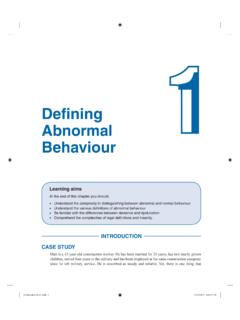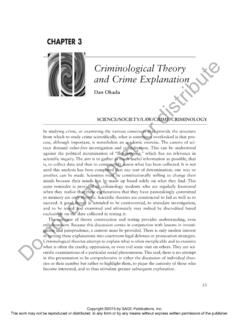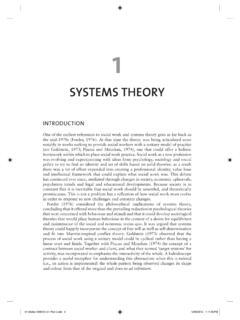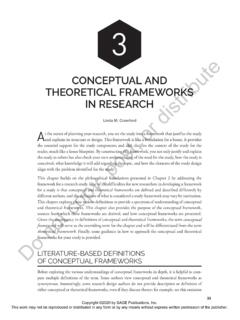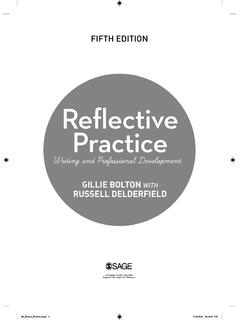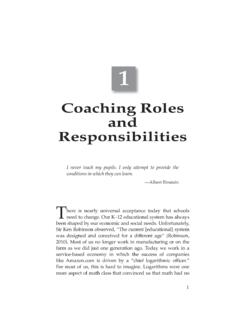Transcription of Crisis Interventions - SAGE Publications Ltd
1 5 Crisis InterventionsSherry was a sophomore at an Ivy League institution when she committed sui-cide. Her parents, who amidst great hardship had emigrated from China, weredevastated by their loss. They could not understand what they had done wrongand continued to blame themselves for the death of their daughter. With encour-agement from Sherry s college counselor, the family eventually agreed to attendfamily counseling, although they did not have much confidence that it wouldhelp. Working from an empowering and ecological framework, the therapist sencouragement was family identified what they had done well for their children, the socialstressors prevalent in their upper-middle-class suburb, and ways to support theirsurviving children.
2 Receiving information about the progression of grief reactionsand what they could anticipate in the future helped the family feel that theycould conquer a hopeless situation. Eventually, the parents were willing to attenda suicide survivors group in a neighboring community to address their familytrauma. They were determined to be better parents to their surviving chapter reviews effective principles and guidelines in Crisis interven-tion. Detailed procedural steps inform the reader how to act immediately,make appropriate assessments of crises, conduct successful Interventions ,and make referrals.
3 Different models of Crisis intervention that assessthe severity of a Crisis from a multidimensional perspective are 1/12/2007 6:29 PM Page 93 Finally, the chapter discusses how to assess suicidal ideation, how to deter-mine suicidal intent, and how to work with survivor (1964) initially defined a Crisis as occurring when individuals are con-fronted with problems that cannot be solved. These irresolvable issues resultin an increase in tension, signs of anxiety, a subsequent state of emotionalunrest, and an inability to function for extended periods.
4 James and Gilliland(2005) define crises as events or situations perceived as intolerably difficultthat exceed an individual s available resources and coping , Roberts (2000) defines a Crisis as a period of psychological dise-quilibrium, experienced as a result of a hazardous event or situation that con-stitutes a significant problem that cannot be remedied by using familiarcoping strategies (p. 7). The Chinese translation of the word Crisis consistsof two separate characters, which paradoxically mean danger and opportu-nity (Greene, Lee, Trask, & Rheinscheld, 2000).
5 Crisis intervention thus pro-vides opportunities for clients to learn new coping skills while identifying,mobilizing, and enhancing those they already following are characteristics of Crisis events: The event precipitating the Crisis is perceived as threatening. There is an apparent inability to modify or reduce the impact of stressful events. There is increased fear, tension, and/or confusion. There is a high level of subjective discomfort. A state of disequilibrium is followed by rapid transition to an active stateof following are examples of crises: An accident (automobile or in home) Death/loss of a loved one Natural disaster Physical illness (self or significant other) Divorce/separation Unemployment Unexpected pregnancy Financial difficultiesThe difficulty in discriminating whether the events listed above constitutecrises or traumas may be obvious.
6 A Crisis is distinguished from a trauma by94 A Practical Approach to 1/12/2007 6:29 PM Page 94 Crisis Interventions 95timing and by how quickly it is resolved. Most crises develop into traumas;conversely, most traumas begin as crises. Socioeconomic status, availability ofemotional support, and the nature of the Crisis will dictate how soon the indi-vidual can resolve it and resume regular functioning. In the aftermath ofHurricane Katrina in September, 2005, two individuals I worked with epito-mized the differences between a Crisis and a trauma:Amelia had moved from New York City to New Orleans to seek employment.
7 Shewas unable to evacuate the city before the hurricane hit. She temporarily stayedat the shelter where I worked as a disaster responder. Although Amelia was deeplyaffected by the pain and suffering that surrounded her, she had a clear plan ofaction. She was resolved to return closer to her family and chalk up her materiallosses in New Orleans to fate. Once her check came in from the American RedCross, Amelia rented a car and drove to her home state. Her former companyassured her that a new job awaited her. Amelia s Crisis would soon be also found himself at the shelter where I worked.
8 However, Kenny, incontrast to Amelia, had lost everything including his childhood home, a parentand a sibling, and his pet dog. Kenny sat on the edge of his cot for hours, wearinga forlorn countenance as he tried to make sense of what had happened. He wasoverwhelmed and unclear about the direction his life would take in the followingfew months. He also anticipated the check from the American Red Cross, thoughhe already knew that it was not going to entirely solve his problems. In the faceof this Crisis , he displayed complete hopelessness and helplessness, and a crisistherefore became a trauma for on CrisisPresumably, crises have always occurred, yet the movement to help individu-als in Crisis did not begin until 1906, when a suicide prevention center calledthe National Save a Life League was established in New York City.
9 Severalyears later, the catalyst for contemporary conceptualization of Crisis workoccurred when Lindemann (1944) and his colleagues from the MassachusettsGeneral Hospital introduced the concepts of Crisis reactions and interventionin the aftermath of the Coconut Grove fire. This fire occurred in a nightclubin Boston in 1943. The concepts are based on the acute and delayed reactionsof the fire s survivors and the family members of its victims. 1/12/2007 6:29 PM Page 95 Expanding on Lindemann s work, Caplan (1961) describes the fourstages of a Crisis reaction as follows:1.
10 An initial rise in tension occurs in response to an Increased tension disrupts daily Unresolved tension results in Failure to resolve the Crisis may result in a psychological the past 10 years, Crisis intervention surged as a specialized field. Thefocus on this field began with the rise in school and community violence aswell as the higher frequency of natural and national disasters. The trademarkof a Crisis is its unpredictability: The Crisis itself is unpredictable, and its abil-ity to affect people is unpredictable as well.


